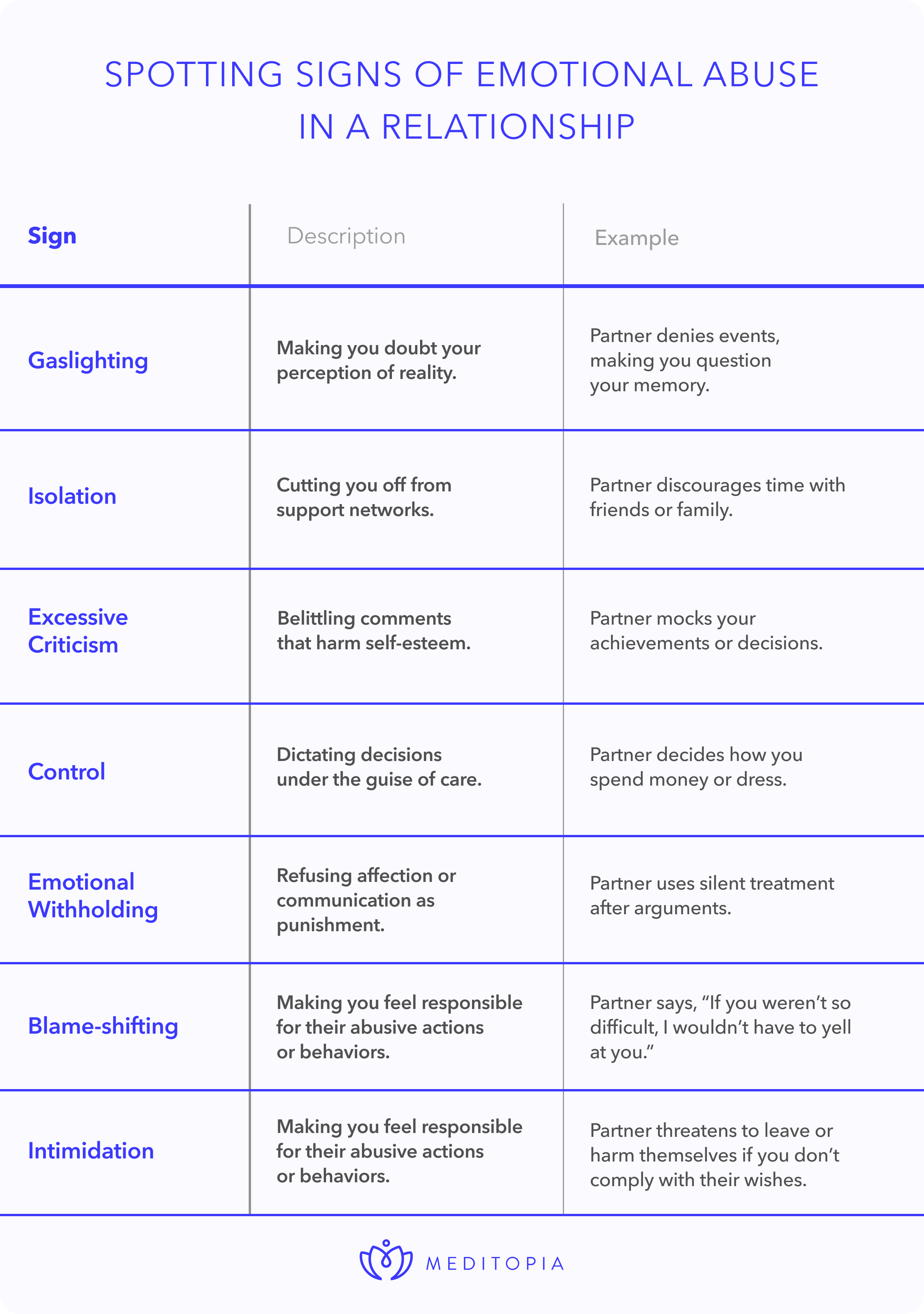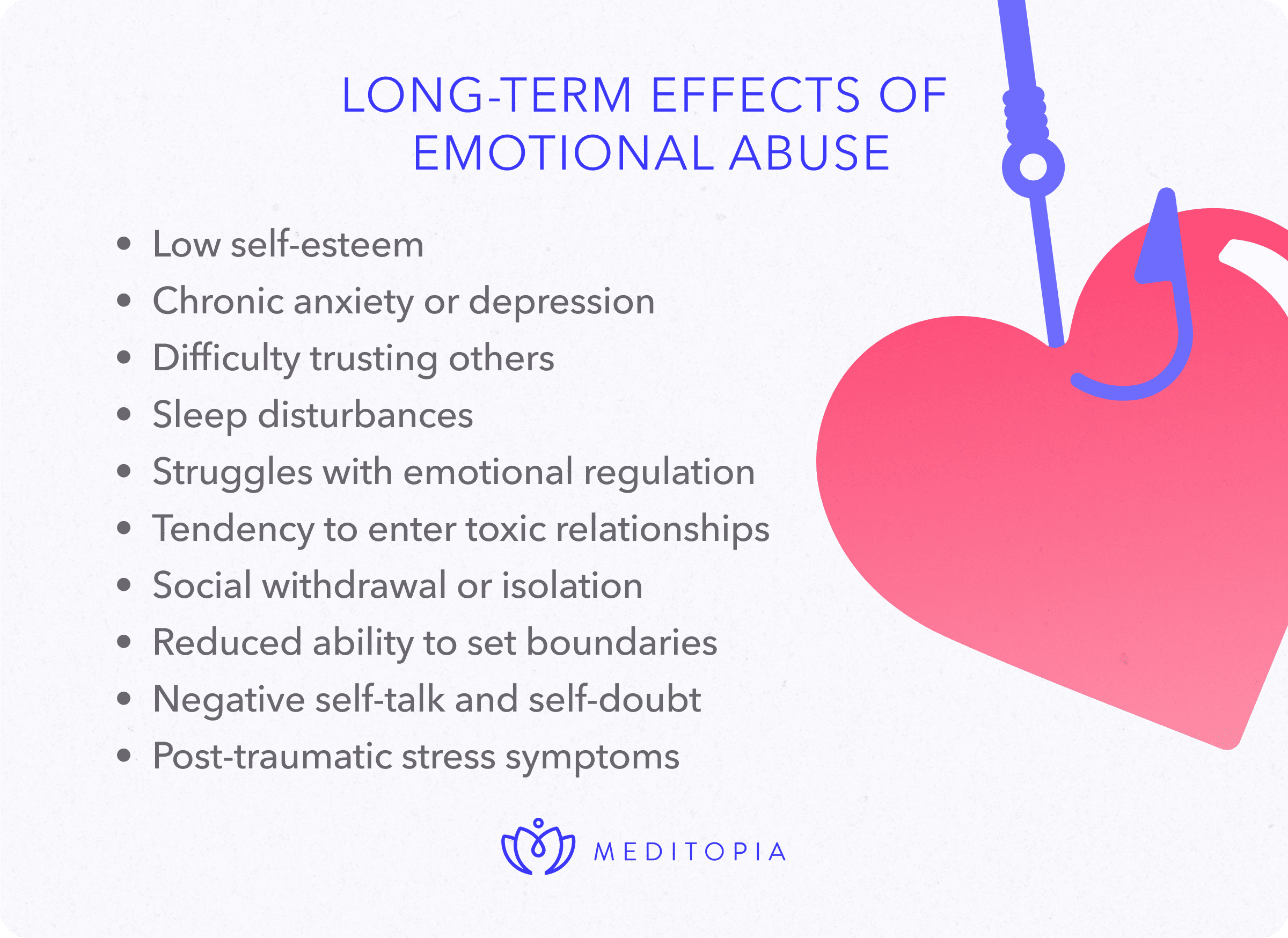Emotional abuse doesn’t always leave visible scars—but its impact can be just as devastating. Unlike healthy conflict, emotional abuse is a persistent pattern of manipulation, control, and psychological harm. Whether you’re questioning your own relationship or supporting someone who is, this guide will help you understand what emotional abuse looks like, how to spot the warning signs, and what steps you can take toward healing and recovery.
What is Emotional Abuse in a Relationship?
Emotional abuse in a relationship refers to a pattern of behavior where one partner uses:
- Manipulation
- Humiliation
- Control
- Or fear
To undermine the other’s self-worth and emotional well-being. Unlike physical abuse, emotional abuse can be subtle and hard to detect, often occurring without shouting or physical harm. Yet its impact can be just as damaging, leading to long-term mental health issues such as anxiety, depression, and trauma.
In a healthy relationship, conflict is normal. Partners may argue, disagree, or hurt each other unintentionally. However, emotional abuse is not about occasional disagreements; it is a consistent pattern of harmful behavior meant to control, demean, or isolate a partner.
The key difference lies in intent and pattern: healthy conflict aims to resolve issues with mutual respect and repair, while emotional abuse seeks to dominate and diminish the other person over time.
In fact, according to the National Domestic Violence Hotline [1], emotional abuse may include:
- Verbal attacks
- Controlling behaviors
- Threats that are used to create an imbalance of power in the relationship

What Does Emotional Abuse Look Like?
This is the story of Christine, she is part of the Meditopia team. She was also in an emotionally abusive relationship, and it took her two years to get out. By the time she did it, she had cut off all contact with family and friends. She was convinced she was "the ugliest and most useless person on the planet." But how did she end up feeling that way?
Why Didn’t She Leave?
One of the most common questions a person that endures emotional abuse in a relationship is that one. “Why didn’t you just leave”? But let's pass the keyboard to the real owner of this story.
"Well, as you can guess, it’s not that simple, mostly because as the victim, you most likely don’t even realize it’s abusive until it’s too far gone. An emotionally abusive relationship isn’t something where there’s just a barrage of insults, all at once.
If it was, I and other victims like me would probably be prompted to not even continue the relationship. In an emotionally abusive relationship, it first starts off well, and then over time, little by little, the subtle insults, manipulative remarks, and passive aggressive comments begin to increase more and more. Essentially, your “partner” chips away at you – your self-confidence, your sense of self – bit by bit, without you even realizing it. They will use insults and criticisms disguised as compliments.They will be be careful in choosing the words they use to criticize you."
Why Didn’t She Fight Back?
"Another thing I’m asked; “Why didn’t you object?” Well, sometimes I did. But it becomes hard to stand up for yourself when your objections are met with “You’re overreacting” or “You’re being over-sensitive” or even “I’m only telling you this because I love you”. It’s responses like this that make you think “Maybe I am overreacting. He’s only trying to help”. And thus, you begin to find blame in yourself. It’s always your fault, never his/hers/theirs."
Truly Believing That It’s Not Your Fault
"But here’s the thing: It’s not your fault. It never was. I wish someone had told me this at the time. In all fairness though, they couldn’t have. I was so programmed to think that everything that went wrong was my fault, that I wouldn’t have been able to hear what was being said. And even if I was, who on earth would have been able to tell me this once I’d cut off all contact with friends and family?
That’s another thing about emotionally abusive relationships: they revolve around control. Your “partner” has to control every aspect of your life.
- Where you go
- What you do
- What you eat
- Who you see
In my case, I saw no one. He convinced me that one friend was only spending time with me because she was broke. Another supposedly didn’t care enough about me to make time for me. My “partner” was the only person that cared about me. He was the only person I could rely on. Or so he had me believe.
When you’re cut off from the rest of the world like this and when you’ve been reprogrammed to think that every little thing is your fault, you inevitably become more attached to your abuser.
The more he mistreats you, the more you crave his warmth and affection. And he does give that. After all, he has to balance out the mistreatment with something. He has to throw you some bait, so you’ll bite and start to think that he really does love you, that things will get better from now on. Trust me, they never will."
Spotting Signs of Emotional Abuse in a Relationship
Recognizing emotional abuse is often challenging, especially when it escalates gradually. If you’ve ever asked yourself, “Am I being emotionally abused?”, it’s worth examining patterns of behavior that go beyond typical relationship struggles.
Here are common signs of emotional abuse that may indicate you are in an unhealthy relationship:

1. Gaslighting
A form of psychological manipulation where your partner denies your experiences or memory of events, making you question your perception of reality. This can include phrases like “You’re too sensitive” or “That never happened.”
2. Isolation
Your partner discourages or prevents you from seeing friends, family, or support systems. Isolation helps the abuser gain control by making you emotionally dependent.
3. Excessive Criticism
Constant belittling, mocking, or demeaning comments about your personality, appearance, or abilities. Over time, this erodes self-confidence and leads to self-doubt.
4. Controlling Behavior
Dictating what you wear, who you talk to, how you spend money, or even where you go. Controlling behavior may be disguised as “concern” or “love,” but its purpose is to dominate.
5. Withholding Affection or Communication
Giving the silent treatment or withdrawing affection as a way to punish or control. This emotional neglect can be just as damaging as verbal aggression.
6. Blame Shifting
The abuser refuses to take responsibility and blames you for their actions. For example: “If you hadn’t made me angry, I wouldn’t have said that.” This dynamic is common in narcissistic relationships.
7. Undermining Boundaries
Your partner repeatedly violates your personal limits (emotionally, physically, or sexually) even after you've clearly expressed discomfort.
8. Public Humiliation or Intimidation
Putting you down in front of others or using threats and intimidation to control behavior. These are examples of emotional abuse from a partner that aim to degrade and assert dominance.
According to the CDC’s National Intimate Partner and Sexual Violence Survey, nearly half of women (47.1%) and men (46.5%) in the U.S. have experienced psychological aggression by an intimate partner in their lifetime [2].
Examples of Emotional Abuse from a Partner
Recognizing emotional abuse often begins with seeing the patterns for what they are. It doesn’t always involve shouting or name-calling; sometimes it’s quiet, calculated, and consistent. If you’ve ever wondered, what does emotional abuse look like?, here are concrete examples that illustrate how it can show up in everyday life.
- Manipulation through guilt: Your partner frequently says things like, “After everything I’ve done for you, you can’t even do this one thing?” They twist situations to make you feel indebted or selfish for asserting your needs. This is a form of emotional abuse from a spouse and can leave you feeling powerless and trapped.
- Verbal insults disguised as jokes: They often mock your weight, intelligence, or clothing, then claim, “You’re too sensitive, it was just a joke.” Over time, this pattern of belittling damages your self-esteem and makes you question your reactions.
- Withholding affection as punishment: After a disagreement, your partner gives you the cold shoulder for days, refusing to speak or show affection. This kind of emotional punishment is used to control your behavior and keep you in a state of fear or insecurity.
- Mentally abusive blame-shifting: You try to express that something they did hurt you, and they immediately turn it around: “You're always the problem in this relationship.” In mentally abusive dynamics, your feelings are dismissed, and the focus shifts to your supposed flaws.
- Controlling through isolation: Your partner becomes upset every time you make plans with friends or family. Eventually, you stop making plans to avoid conflict. Isolation like this is subtle but dangerous, it slowly cuts you off from support systems.
- Constant monitoring or jealousy: Your phone is checked regularly. You're questioned about who you talked to, what you wore, and where you went. These actions aren’t love; they’re control tactics rooted in insecurity and dominance.

Emotional Abuse vs. Physical Abuse vs. Conflict
While mental and emotional abuse doesn't leave physical scars, it can be just as damaging—if not more—because it often occurs in a hidden, ongoing way. Over time, a mentally abusive relationship can erode your sense of self and make you doubt your experiences.
Recognizing the distinctions between conflict and abuse empowers individuals to assess their relationships more clearly, and take steps toward healing and recovery when needed.
Emotional Abuse
Emotional abuse, sometimes referred to as psychological or verbal abuse, involves non-physical behaviors that manipulate, belittle, or control a partner. This type of abuse may not leave bruises, but it often leaves deep, invisible wounds. It includes actions like constant criticism, gaslighting, emotional withdrawal, and intimidation.
Example: A partner routinely calls you “worthless,” mocks your ideas, and threatens to leave whenever you express discomfort. These are clear signs of an emotionally abusive partner, they seek to control through fear and emotional dependency.
Physical Abuse
Physical abuse includes any intentional use of physical force meant to cause harm, fear, or intimidation. This may involve hitting, slapping, pushing, choking, or destroying property to assert control.
Example: A partner punches the wall during arguments, throws objects, or physically restrains you when you try to leave the room. The threat or use of violence to gain power makes this more than just conflict, it’s abuse.
Conflict
All couples argue from time to time. Healthy conflict involves disagreements, emotional expression, and even occasional frustration—but with mutual respect, listening, and repair. The goal is resolution, not control or harm.
Example: You and your partner disagree over financial decisions, raise your voices, and take time to cool off—then come back to find a compromise. There’s no name-calling, fear, or retaliation involved.

How to Deal with Emotional Abuse
Recognizing emotional abuse is a courageous first step. The next—equally important—is figuring out how to protect your mental health and move toward safety and self-respect. While every situation is unique, here are key steps you can take to cope with and address emotional abuse:
1. Acknowledge the Abuse Without Minimizing It
It's common to downplay emotional harm, especially if there's no physical violence. But abuse is abuse. Naming it is a powerful act of reclaiming your reality and worth.
2. Document Patterns and Incidents
Keep a journal (physical or digital) where you note specific instances of emotional abuse, how it made you feel, and any related events. This can help validate your experiences and provide clarity, especially if you decide to seek professional or legal support.
3. Talk to Someone You Trust
Isolation thrives in silence. Reach out to a friend, family member, or therapist who can offer support, perspective, and safety. You are not alone—and your story matters.
4. Consider Professional Support
Working with a licensed therapist or counselor can help you rebuild your sense of self, process trauma, and create a plan to move forward—whether that means healing within the relationship or leaving it.
5. Make a Safety Plan if Necessary
If the situation is escalating or you're unsure about your safety, especially if emotional abuse coexists with financial or physical control, it’s crucial to create a safety plan. This may include emergency contacts, safe places to go, and access to important documents.
6. Explore Your Options
Leaving an emotionally abusive relationship is often difficult, emotionally, logistically, and financially. But staying isn't your only option. Support organizations, legal aid, and local shelters can help you understand and navigate your next steps.
Please, do not be afraid to talk back to the old support sytem you had. Talk to friends, family, old college buddies or coworkers. It will help you feel less overwhelmed, heard, and they can help you through this challenging process. Remain safe, remember you are loved, and do not hesitate to call authorities when necessary.
7 Ways to Break Out of an Abusive Relationship
Breaking out of an abusive relationship is not a one-size-fits-all process. It often begins with subtle realizations and builds over time until you reach a breaking point. Here's a structured look at one person’s journey, and additional ways others can seek support:
1. Recognizing the Breaking Point
- Emotional abuse can continue unnoticed until the mental toll becomes unbearable.
- Signs like persistent anxiety, panic attacks, and sleepless nights may signal that something is deeply wrong; even before acknowledging it as abuse.
2. Leaning on Family Support
- Reconnection with parents and siblings who refused to give up, even after attempts to push them away.
- Loved ones simply listen without judgment, allowing space to vent and reflect.
- Their presence remind you that you are not alone and that support is available.
3. Therapy and Professional Guidance
- Therapy helps you see the relationship with clarity and objectivity.
- A therapist can help you dissolve internalized blame and challenge negative self-beliefs instilled by the abuser.
- Professional support offers structured tools for emotional healing and decision-making.
4. Exploring Meditation for Self-Awareness
- Meditation helps to confront anxiety and quiet self-derogatory thoughts through self-compassion.
- Practicing mindfulness makes you understand that those thoughts are not facts, or even personal truths.
- This emotional distance makes room for self-acceptance and the belief: “It’s not your fault.”
- Meditopia is here for you. Download the app, answer the initial questionnaire, and access our exclusive Relatinoship Program to gain awareness and healing.
5. Accepting the Loss of Self—and Rebuilding
- Realization that identity and confidence has been shaped by someone else's control.
- Recovery involves reclaiming personal values, choices, and self-worth over time.
6. Educate Yourself About Emotional Abuse
- Learn terms like gaslighting, emotional punishment, and trauma responses can help put a name to your experience.
- Understanding the cycle of abuse helps break the illusion that things will "get better" without change.
7. Join a Support Group
- Speaking with others who’ve experienced similar abuse can validate your feelings and offer real-life insights.
- Support groups—online or in-person—provide non-judgmental community and collective strength.





















